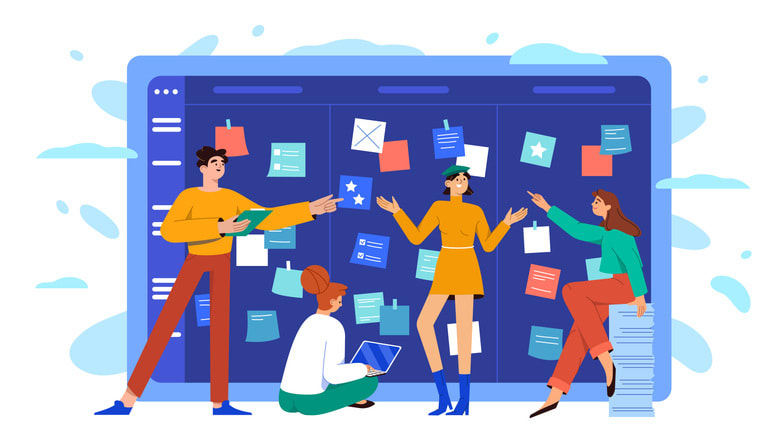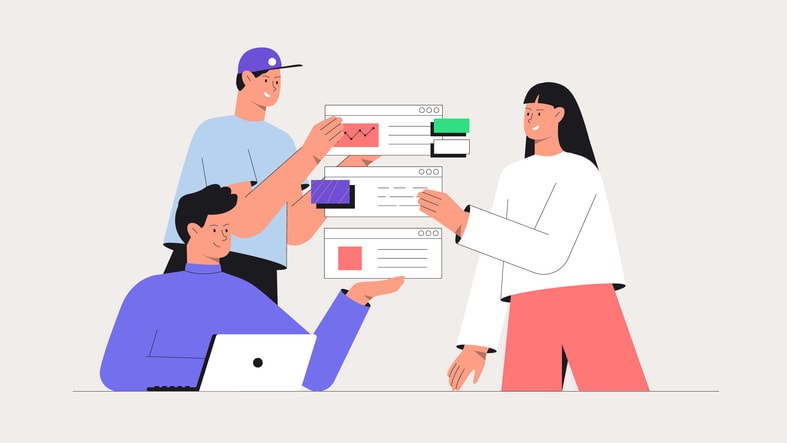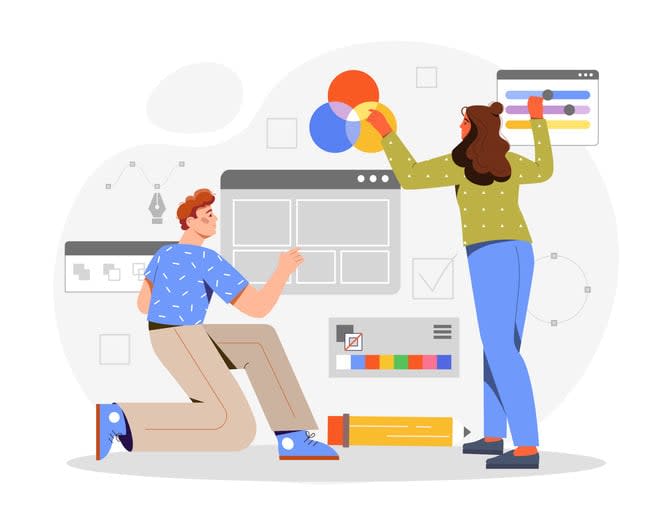Are you embarking on a design project and need to master the design process steps? This guide lays out the fundamental phases, from empathizing with users to iterative refinement, that will transform your ideas into compelling designs. Learn how to navigate these critical steps to craft solutions that meet user needs and excel in the market.
Key Takeaways
- A user-centric design process enhances product development by focusing on user needs and experiences. It fosters empathy and inclusivity and leads to innovative and deeply resonant solutions.
- Design thinking is inherently iterative, with flexibility for revisiting and refining stages based on emerging insights, and prioritizes adaptability to maintain relevance and responsiveness to user feedback and market dynamics.
- The design process is adaptable across industries and can benefit from integrating project management tools, which standardize stages and foster effective cross-functional collaboration by centralizing design feedback and enhancing workflow efficiency.
The importance of a user-centric design process

You have started a company, built a remote team, and have your own Kumospace office as the business's beating heart. Now, you need to plan and design the product to drive you all to success.
Unlocking the full potential of any product begins with placing the customer or end user at the heart of the design process. This transformative approach aligns with user expectations and forges a path to developing solutions that meet their needs. The power of user-centric design is evident when we observe products that have transcended the marketplace to become integral parts of people’s lives, fostering a connection that goes beyond utility.
From the intuitive interfaces of our favorite apps to the ergonomic handles of our kitchen tools, the impact of user-centered design is all around us. It proves that when design teams listen, collaborate, and respond to user needs, they craft products and experiences that improve lives.
Understanding user needs
Exploring users' minds and lives is not a one-off task but a continuous journey of discovery. By engaging with real users throughout the development cycle, design teams can weave a rich tapestry of insights that define and drive the design thinking process. Observations, user tests, and research are the tools that bring us closer to understanding the end user’s desires and challenges.
This human-centered exploration uncovers patterns and problems affecting a diverse range of users, ensuring that the solutions we create are not just innovative but inclusive. The empathy gathered from user research is the foundation upon which software that caters to various user groups is built.
Each design team needs to extract user insights, build them into the product, and evolve further iterations, as needs and trends change, all within a collaborative atmosphere that makes it simpler to drive culture and share resources.
Fostering innovation through user-centricity
When design teams adopt a user-centric approach, they open the doors to empathy and inclusivity, crucial ingredients for stirring the pot of innovation. It’s not just about designing something new; it’s about crafting innovative solutions that strike a chord with the target user, and boosting growth for the business.
Take Airbnb, for example—a company that turned user feedback and simple prototypes into a billion-dollar business model, demonstrating the potent combination of user-centered design and business acumen.
By embedding the ideation phase within a framework that values user input, design thinkers can transform creative ideas into innovative ideas that meet and exceed user expectations and stand out in the marketplace.
The iterative nature of design thinking

Design thinking is not a straight line but a dynamic dance that loops and spirals, guided by an iterative process. It’s a non-linear journey that allows design teams to:
- Generate ideas (from marketing to product)
- Prototype
- Test
- Circle back to refine and enhance ideas and product
This rhythm of creation and revision, where each step informs the next, ensures that the final design is not just a product of sequential steps but a reflection of as many ideas and iterations as necessary to achieve excellence.
Embracing this iterative approach means that a design thinking model is always current, always evolving, and always tuned to the pulse of user needs and market demands.
Revisiting previous stages
The beauty of design thinking lies in its flexibility, allowing for a dance between stages that are not bound by a rigid sequence. This adaptable methodology means design teams can collaborate to revisit previous stages as new insights emerge, ensuring that the solution remains relevant and responsive. By transforming scattered observations into actionable insights, designers can refine their understanding of the problem and solution spaces, making the journey to the final design a rich tapestry of learning and evolution.
Empathy maps and other tools serve as guides, reminding us of the human context of the problem and enabling a deeper connection with the user experience. Through this flexibility, teams can gracefully pivot, adapting their strategies to newfound insights or unforeseen challenges and revisiting key steps to ensure that the design intent remains clear and focused.
Embracing flexibility
Flexibility in the design process is a double-edged sword; it must be wielded with care to ensure that it adapts to trends and business needs, while preserving the brand’s core. Excessive flexibility can dilute a brand’s identity, leading to a fragmented presence, whereas a rigid process can stifle innovation and responsiveness.
A considered approach to flexibility involves:
- designing components that are versatile yet standardized
- supporting diverse business needs without compromising coherence
- allowing designers to navigate changes and embrace new challenges
- leading to more effective problem-solving and innovation in the design process, as well as exploring alternative solutions.
Furthermore, adaptability in design thinking aids in making informed decisions that improve user experiences and overcome unexpected changes, leading to designs that more effectively meet user needs and business goals. Embracing this flexible and adaptable mindset can also enhance job satisfaction and work-life balance for designers, contributing to a more positive and productive work environment.
A step-by-step breakdown of the design process

The design process is a journey that transforms large, complex projects into manageable, actionable stages, each one building upon the insights and learnings of the last. It’s a comprehensive guide that starts with empathy, moves through ideation, and culminates in the final design—all with the end consumer in mind. This phased approach ensures that designers create products or services that resonate with customers and stand the test of time.
From empathizing with user needs to defining the design intent and generating creative ideas, each step is critical to the overall project's success. And as we move deeper into more detail, we find ourselves in a space where creativity is king, and the quantity of ideas is valued over feasibility in the ideation phase. This dedication to understanding the user and fostering innovation sets the stage for design development, where the schematic design lays the foundation for a solution that truly meets user needs.
Meetings are required for each step, varying from formal process-movers to brainstorming and tactical discussions. Effective meeting management is key to succeeding at each step, but platforms like Kumospace enable teams to solve issues faster.
Identifying and defining the problem
Identifying and defining the problem at the very beginning of the design process requires a laser focus on user needs. It’s about setting aside business objectives and looking at the problem through the lens of those we are designing for. Creating a clear and informed problem statement is a key step that guides the entire product design process, underpinned by the programming phase, where design criteria are established.
This stage draws upon the unique aspects of the user’s experience, ensuring that the design team doesn’t just solve problems but solves the right problems. It’s a critical part of the process, as unclear vision and poor requirement gathering can lead to project failures—a risk no design team can afford to take.
Research and exploration
Research and exploration are the pillars upon which potential solutions are built in the quest for innovative solutions. This stage is a treasure hunt for insights into the market state, competing products, and, most importantly, user needs. It’s where design teams don their detective hats, sifting through information to uncover the key differentiator that will set their product apart.
Armed with a deep understanding of the landscape, designers can confidently move forward, knowing that their creative ideas are grounded in reality and can help solve complex problems for their prospects and customers, as well as deliver appropriate marketing messages.
Generating creative ideas
The ideation stage is a playground for the imagination, where the sky’s the limit and every idea, no matter how wild, is welcomed. Techniques such as Brainstorm, Brainwrite, and SCAMPER unlock the floodgates of creativity, encouraging participants to generate as many ideas as possible. It’s a phase of diversity and abundance where the goal is to cast a wide net and explore many possible solutions.
In these brainstorming sessions, it’s essential to foster a space where judgment is deferred and everyone, from the intern to the CEO, contributes to the collective pool of ideas. As the session progresses, the design process naturally gravitates toward:
- selecting the most promising ideas
- aligning with the problem statement
- ensuring that the team stays on course to create products that effectively resolve user issues.
Prototyping and experimentation
Prototyping is the tangible expression of the ideation phase, where concepts take shape and are put to the test. It’s the act of bringing ideas to life in scaled-down, low-fidelity formats that can be explored and refined. This cycle of prototyping and experimentation is integral to iterative design, especially in digital experiences, where it allows for continuous evolution and user feedback.
Rapid prototyping, a staple in user experience (UX) and graphic design, lets designers quickly create functional drafts and gauge user reactions, ensuring that the design thinking process remains dynamic and user-centered.
Testing and refining solutions
The testing phase is where the rubber meets the road, and the design is put under the microscope. User testing provides a window into the audience’s mind, revealing whether the solutions crafted truly address their problems. It’s a stage where data and feedback become the cornerstones of decision-making, allowing design teams to refine the final product to perfection.
From uncovering usability issues to iterative design cycles that enhance digital marketing efficiency, testing is an opportunity to polish and perfect. Extensive user testing also means that design flaws can be identified and rectified early on, saving time, reducing frustration, and ultimately leading to a finished product that delights users and meets business goals
Implementing design thinking workshops

Design thinking workshops are the crucibles where diverse minds come together to meld empathy with innovation. These workshops are designed to walk participants through each step of the process, from the initial spark of empathy to the tangible reality of prototyping and testing. They are a testament to the power of co-creation, where blending the roles of creator and consumer leads to solutions that are deeply aligned with user needs.
It’s this collaborative spirit, underpinned by participatory design workshops and ideation sessions, that has led to significant cultural shifts in companies, fostering enhanced customer loyalty and team engagement.
Workshop structure and techniques
The success of a design thinking workshop hinges on its structure and techniques. Preparation is key, involving clear objectives, a conducive location, a well-planned agenda, and the right materials. The magic happens when a diverse group of 6 to 12 participants comes together, bringing a wealth of perspectives and ensuring effective collaboration.
A carefully curated agenda, punctuated with a variety of activities, keeps the energy high and the participants fully engaged, allowing for a productive and creative session that yields tangible results.
The role of facilitators
Facilitators are the maestros of design thinking workshops, guiding participants through the process with a mix of presentation prowess and the ability to keep the group captivated. They create an environment where every participant feels empowered to contribute, ensuring that the workshop’s goals are met and that the group remains focused and energized throughout the design thinking journey.
Adapting the design process across industries

The design process's versatility is its strength, allowing it to be tailored to fit distinct needs across various industries. Whether it’s the precision of engineering, the tangibility of manufacturing, or the digital finesse of graphic or UX design, the foundational steps of the design process are adaptable, ensuring that design-led companies can innovate and thrive in their respective fields.
Engineering design processes
The engineering design process is meticulous and measured, emphasizing research that includes materials, building standards, and project scope. It’s a discipline where applied science and engineering sciences converge to optimize designs to meet project objectives. Drawing on past experiences from similar projects ensures that lessons learned are integrated, preventing the recurrence of previous issues.
And at the end of the process, effective communication of results, typically through detailed documentation and presentations, marks the completion of a well-executed engineering design project.
Manufacturing or physical product design processes
In the manufacturing realm, the design process is a journey from the initial spark of an idea to the final product launch. This lifecycle encompasses:
- Concept generation
- Design
- Engineering
- Manufacturing stages
Each stage has its own set of detailed plans and prototypes.
The product development process typically involves several stages, including:
- Ideation: Generate and refine ideas for a new product using a project launch.
- Research: Conduct market research and gather customer insights to inform the product design.
- Design: Create a prototype or mock-up of the product to test its functionality and aesthetics.
- Testing: Conduct rigorous testing to ensure the product meets quality and safety standards.
- Manufacturing: Scaling up production and mass-producing the product.
- Launch: Planning and executing a successful market introduction for the product.
Each stage is important and contributes to the overall success of the product development process.
Post-launch, the process continues as consumer feedback is gathered and used to refine and improve the product in future iterations.
Graphic or UX design processes
The graphic and UX design processes stand as beacons of user-centered design principles, prioritizing the needs and experiences of the user to propel software quality and satisfaction to new heights. These disciplines embrace a methodical yet creative approach, where user research, ideation, and testing are woven together to ensure that the final design looks good and feels intuitive and accessible to the end user.
By placing the user at the core of every decision, graphic and UX designers craft experiences that are not only aesthetically pleasing but also functionally seamless, setting a standard for excellence in the industry.
Integrating design processes with your project Management tools

The complexity of the design process necessitates using project management tools to bring clarity and structure to the creative chaos. These tools are the backbone of the process, standardizing stages and ensuring that each team member understands their deliverables and deadlines. Platforms like monday.com exemplify the integration of project management with design, providing customizable dashboards and workflows that accommodate the unique needs of design projects.
Similarly, tools like Filestage streamline the review process, offering analytics and automation that enhance the efficiency of managing design projects.
Customizable workflow templates
The ability to customize workflow templates is a game-changer, allowing businesses to tailor their processes to eliminate inefficiencies and improve overall workflow. With tools like monday.com, design teams can create workflows that are perfectly aligned with their project needs, enhancing standardization and optimizing the design process.
These customizable workflow templates can be visualized through flowcharts, making it easier for teams to communicate and collaborate effectively.
Cross-functional collaboration
Effective cross-functional collaboration is the lifeblood of any successful design process, and tools that centralize design feedback are key to achieving this. By using platforms like Filestage, design teams can bring together feedback from various departments in a single location, fostering discussions that lead to more informed and cohesive design decisions.
This centralized approach ensures that the insights gathered from customer interactions are used efficiently to speed up the design and decision-making process.
Summary
To master the design process is to understand that it is both an art and a science—a series of steps that guide you from understanding the user needs to deliver a product that resonates with them. Throughout this guide, we’ve explored the importance of a user-centric approach, the iterative nature of design thinking, and the practical steps that bring an idea to life. We’ve seen how design thinking workshops can foster innovation and collaboration and how the design process adapts across industries. Finally, we’ve examined the role of project management tools in streamlining the design process. With these insights, you’re now equipped with a comprehensive roadmap to navigate the complex yet rewarding world of design. May your journey be filled with creativity, empathy, and success.
Frequently Asked Questions
User-centered design is an approach that prioritizes the needs, preferences, and feedback of users to create products and services that align with user expectations and enhance their experience.
An iterative process in design thinking is important because it allows design teams to continuously refine and improve their ideas and solutions based on user feedback and changing market demands, ensuring the final product meets user needs and stays relevant.
The design process differs across industries due to the need to meet specific requirements of each field. For instance, engineering design focuses on materials and standards, while graphic or UX design prioritizes the end user’s experience.
Project management tools benefit the design process by standardizing workflows, providing clear deadlines, enhancing collaboration, centralizing feedback, and automating tasks to increase efficiency and effectiveness. These tools streamline the design process by providing clear processes and deliverables, ultimately improving the overall design workflow.
Facilitators in design thinking workshops guide participants through the process, maintain engagement, and ensure workshop objectives are achieved by creating an environment for participation and creativity. Using apps like Kumospace can help leaders and teams work smarter and faster than those reliant on enterprise applications and their slow-paced solutions.





